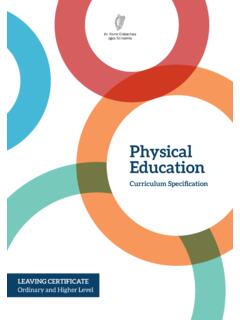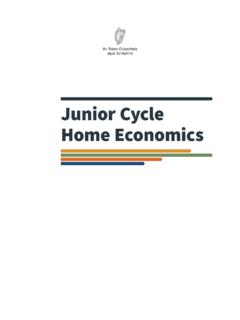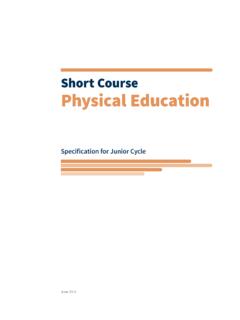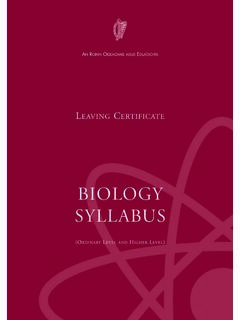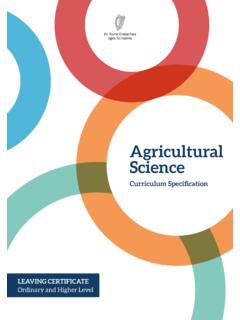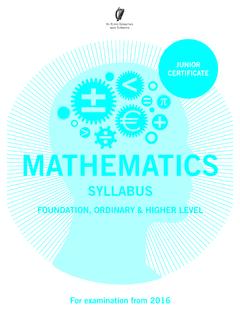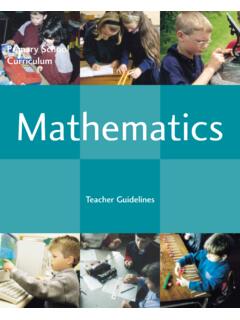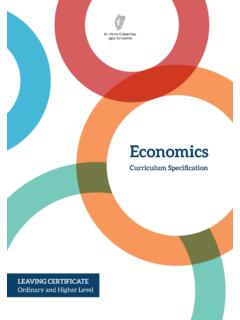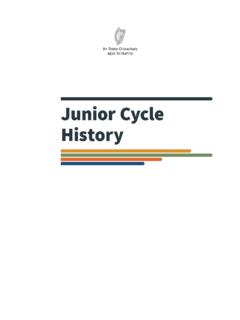Transcription of Junior ycle Home Economics - Curriculum
1 0 Junior Cycle Home Economics Guidelines for the Classroom-Based Assessments January 2019 1 March 2018 2 Contents Introduction 4 Classroom-Based Assessments: General Information 5 Classroom-Based Assessments in Home Economics 8 Classroom-Based assessment 1: Creative Textiles 9 Completing the Classroom-Based assessment 1: Creative Textiles 11 Creative Textiles: Advice for students 13 Deciding on the level of achievement: Creative Textiles 14 Features of Quality: Creative Textiles 16 Classroom-Based assessment 2: Food Literacy Skills Brief 17 Completing the Classroom-Based assessment 2: Food Literacy Skills Brief 19 Food Literacy Skills Brief: Advice for students 21 Deciding on the level of achievement: Food Literacy Skills Brief 22 Features of Quality: Food Literacy Skills Brief 24 Subject Learning and assessment Review meeting 25 Recording and reporting results from Classroom-Based Assessments 25 Useful links 27 Appendix 1: Subject Learning and assessment Review Meeting 28 Appendix 2: Subject Learning and assessment Review Meeting.
2 Facilitator s report 32 3 4 Introduction This document, Junior Cycle Home Economics : Guidelines for the Classroom-Based assessment , provides general information on Classroom-Based Assessments detail of the nature and scope of the Classroom-Based assessment described in the Curriculum specification for Junior Cycle Home Economics the Features of Quality used to describe the level of achievement for each Classroom-Based assessment guidelines for schools, teachers and students on completing the Classroom-Based Assessments. These guidelines should be used in conjunction with the Curriculum specification for Junior Cycle Home Economics , which can be accessed at 5 Classroom-Based Assessments: General Information Classroom-Based Assessments (CBA) are best described as the occasions when the teacher assesses the students using the specific tasks set out in the subject specification.
3 They are included within the time allocated for Home Economics , which is a minimum of 200 hours. The Classroom-Based Assessments and the Features of Quality, which support teacher judgement, are set out in these guidelines. The purpose of assessment at this stage of education is to support learning. While Classroom-Based Assessments are summative, they have a formative value and should be used as a tool to provide feedback to students, parents and teachers on student progress and learning. Providing focused feedback to students on their learning is a critical component of high-quality assessment and a key factor in building students capacity to manage their own learning and their motivation to stick with a complex task or problem.
4 The teacher s judgement of the student s work arising from the Classroom-Based assessment is recorded for the Subject Learning and assessment Review (SLAR) meeting and is used in the school s reporting to parents and students on the Junior Cycle Profile of Achievement (JCPA). Students undertake the Classroom-Based Assessments over specified periods of time in second and third year. The results of other projects, homework or tests undertaken by the students in the course of their normal classwork do not add up to the award of a descriptor for the Classroom-Based assessment . The autonomy of the school in preparing students for the Classroom-Based Assessments There are two Classroom-Based Assessments in Home Economics .
5 They are assessed at a common level. These guidelines set out a range of options for the Classroom-Based Assessments so that they can suit the particular needs and circumstances of students and the school. The first Classroom-Based assessment is completed in Year 2. Students and teachers have a choice of two options from which to choose a Creative Textiles project. The second Classroom-Based assessment is completed in Year 3 and is directly linked to the practical food skills examination. This Classroom-Based assessment is based on a food literacy skills brief selected from a list of briefs issued annually by the State Examinations Commission.
6 Students draw a brief under the supervision of the 6 teacher from the list provided by the State Examinations Commission. Students utilise the design brief process to research, generate ideas and possible solutions for the chosen brief. Within the parameters set by these guidelines, the range of approaches in both Classroom-Based Assessments can be determined independently by the school, teachers and students. How the school supports the completion of the Classroom-Based Assessments The school supports the completion of the assessments by: ensuring that the NCCA Junior Cycle Home Economics Specification and Junior Cycle Home Economics .
7 Guidelines for the Classroom-Based assessment are provided to teachers ensuring the projects presented for the Classroom-Based Assessments is the students own work supporting teachers in recording the level descriptors awarded to each student retaining records and pieces of work, as appropriate, for the purposes of Subject Learning and assessment Review (SLAR) meetings applying the guidelines for Subject Learning and assessment Review (SLAR) meetings applying inclusive assessment practices and ensuring accessibility of assessment for all students reporting the outcomes of Classroom-Based Assessments to students and their parents/guardians as part of the school s reporting procedures and through the Junior Cycle Profile of Achievement (JCPA) Further information can be found at Reasonable support To facilitate providing feedback to students during their engagement with assessment , the process of completing the Classroom-Based Assessments should be viewed as part of teaching and learning, and not solely for assessment purposes.
8 It is envisaged that teachers will guide, support and supervise throughout the process. If a student requires more than what could be deemed as reasonable support, the teacher can make a note of the level of assistance provided. The level of initiative demonstrated by the students is an element of the Features of Quality used to decide the level of achievement of the student s work. Support may include: clarifying the requirements of the task using annotated examples of student work to clarify the meaning and interpretation of the Features of Quality to students 7 providing instructions at strategic intervals to facilitate the timely completion of the assessments providing supports for students with special educational needs (SEN) as outlined below.
9 Note that only work which is the student s own can be accepted for assessment in the JCPA. It is not envisaged that the level of support involved requires teachers to edit draft work, to provide model answers or to alter a student s textile work to provide perfect samples of work to be used as a student s evidence of learning. Inclusive assessment practices Schools facilitate inclusive assessment practices whether as part of ongoing assessment or Classroom-Based Assessments. Where a school judges that a student has a specific physical or learning difficulty, reasonable supports may be put in place to remove, as far as possible, the impact of the disability on the student s performance in Classroom-Based Assessments.
10 These supports the support provided by a special needs assistant or the support of assistive technologies, should be in line with the arrangements the school has put in place to support the student s learning throughout the year. 8 Classroom-Based Assessments in Home Economics There are two Classroom-Based Assessments in Home Economics . They are assessed at a common level. They relate to learning outcomes and are scheduled to be undertaken by students in a time period under the supervision of the class teacher to a national timetable (as advised by the NCCA) in the school calendar.
